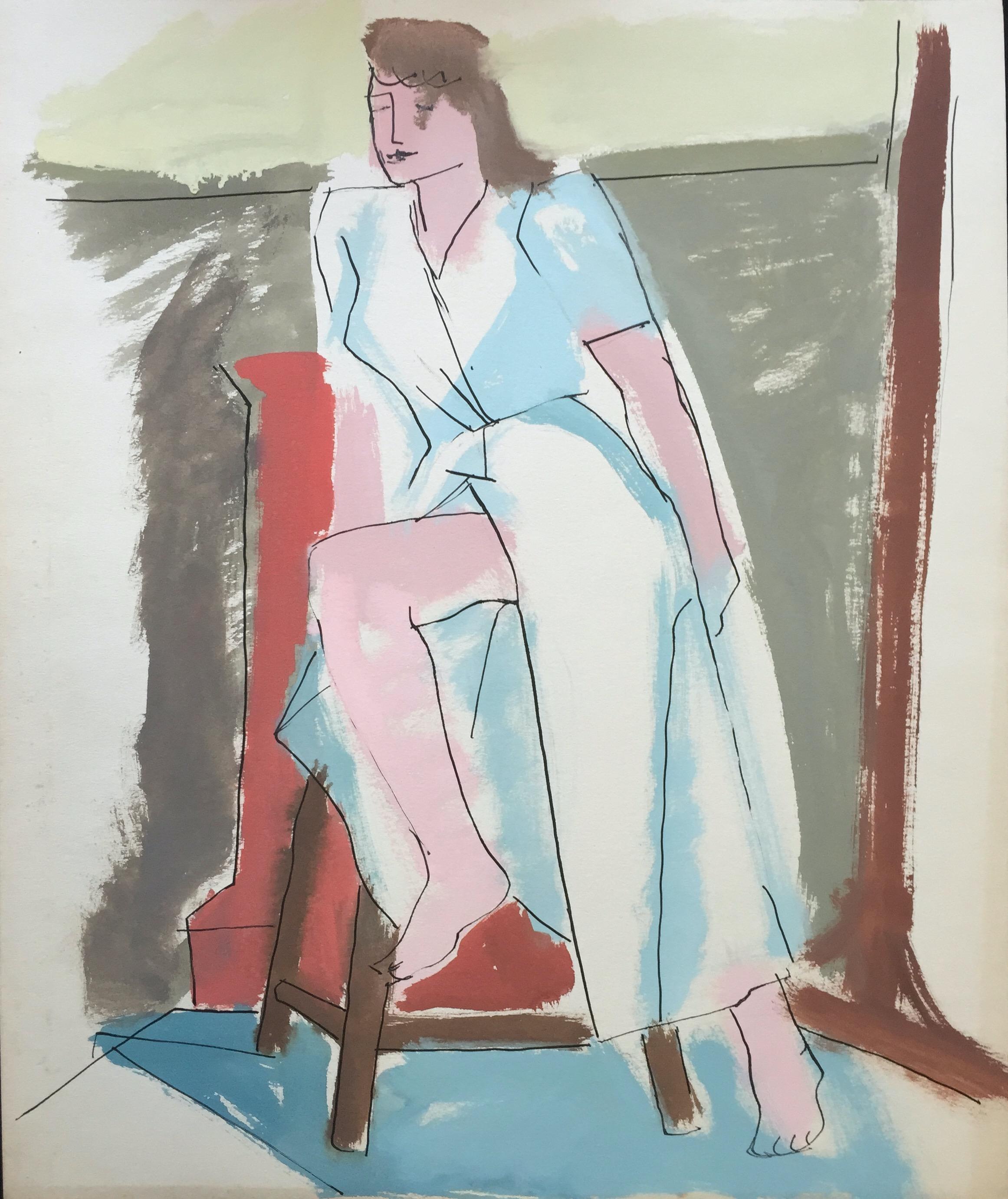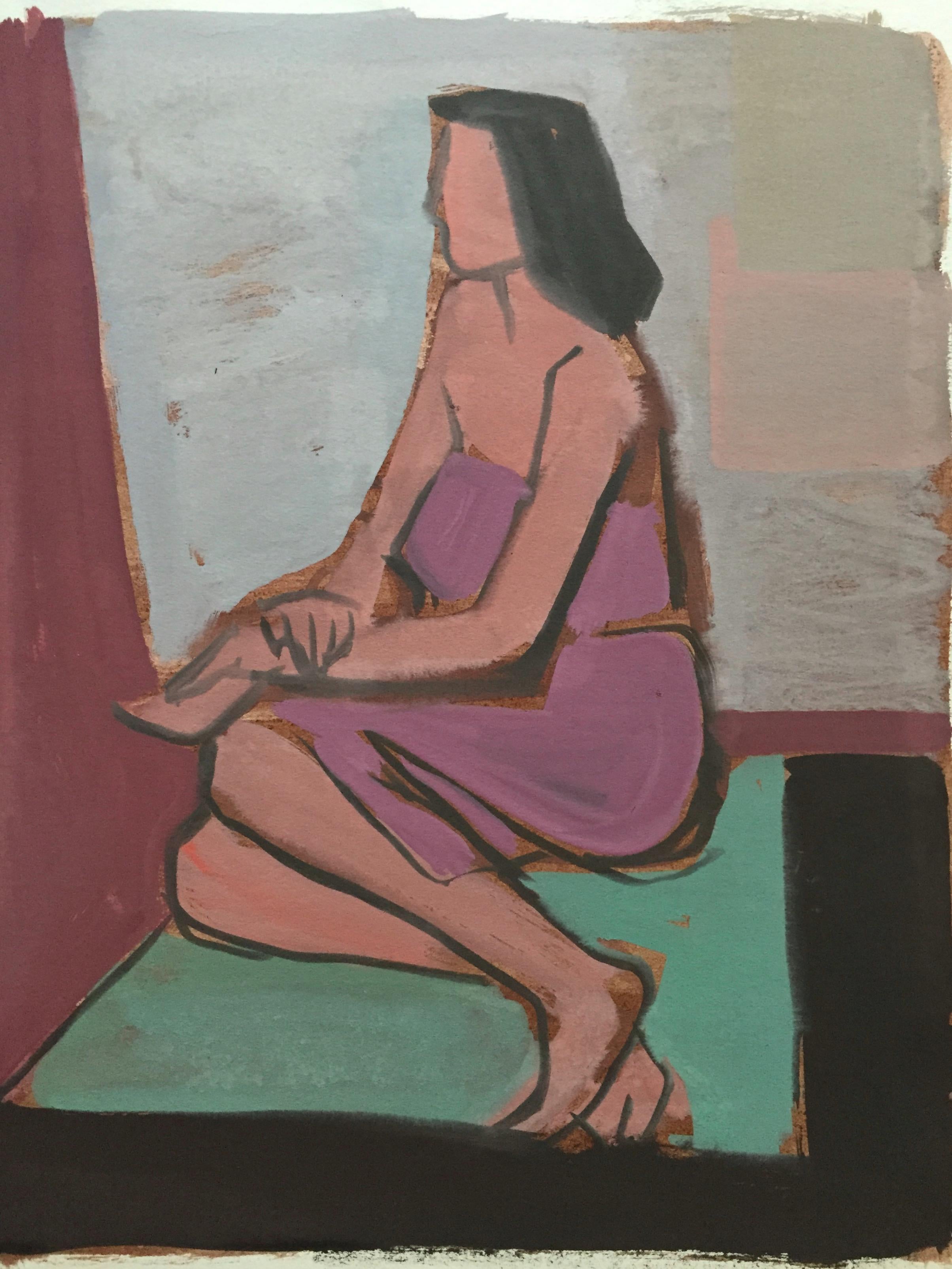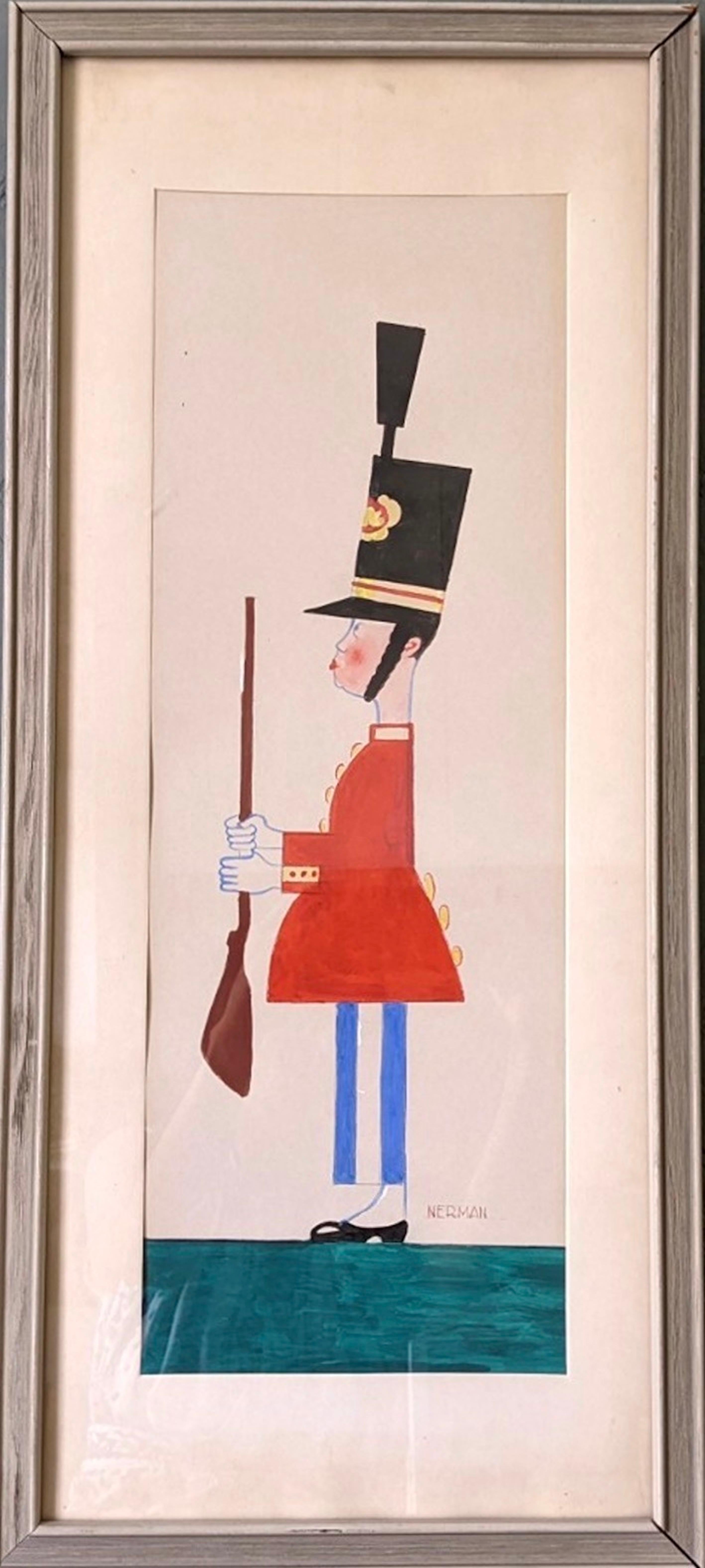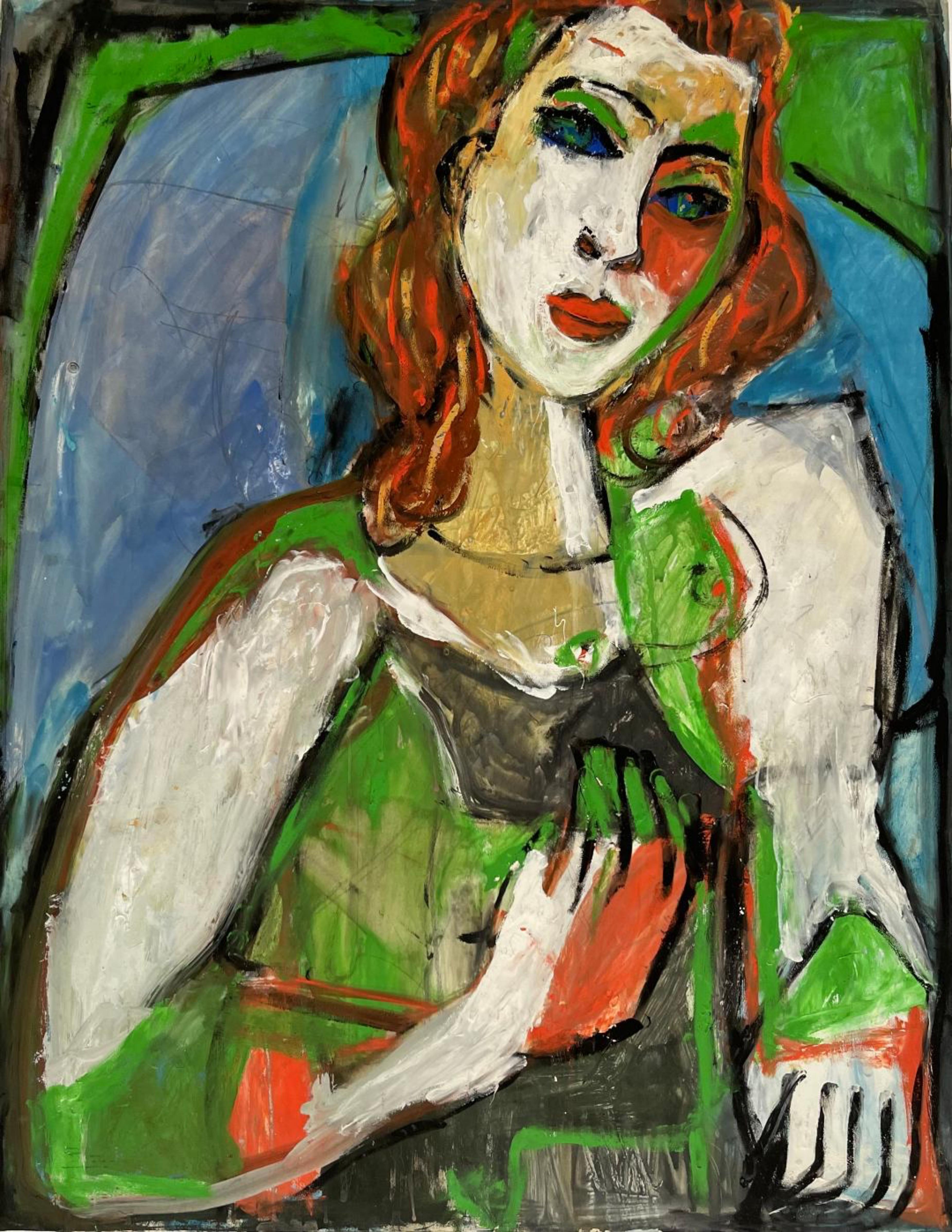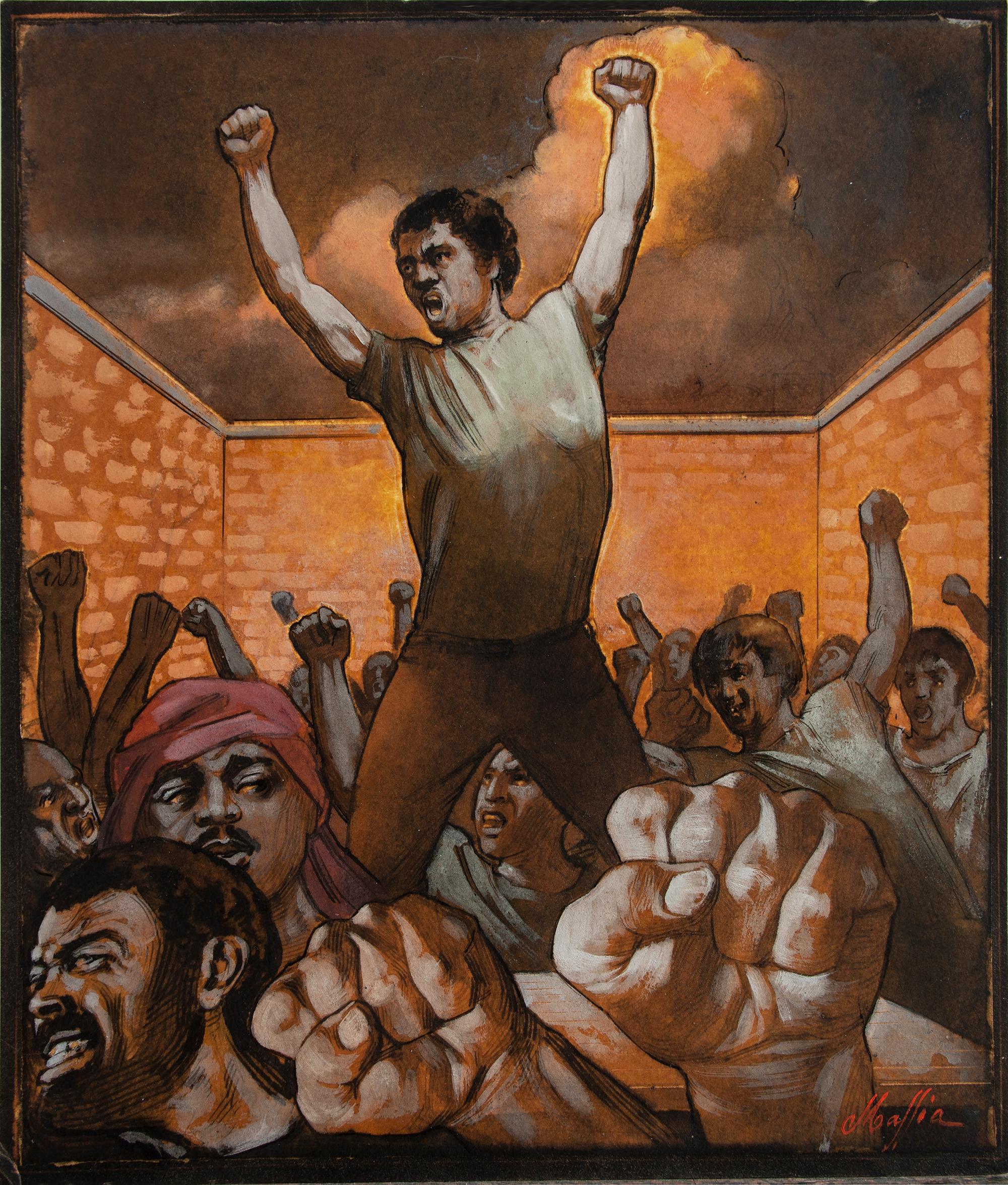Items Similar to Large Gouache Original Painting Mother & Daughter Sandu Liberman Israeli Judaica
Want more images or videos?
Request additional images or videos from the seller
1 of 11
Sandu LibermanLarge Gouache Original Painting Mother & Daughter Sandu Liberman Israeli Judaica
About the Item
framed 36 X 28 board 30 X 21.75
Sandu Liberman (Romanian-Israeli) was born in Yasi, Romania in 1923. between 1946 and 1953 he took part in the state art shows in Bucharest. in 1952 he was awarded the gold medal at the International Art Festival in Romania. that same year he was commissioned to illustrate the large encyclopedia Rumania, and was appointed Official Portrait Artist of Romania. He went to Israel in 1962 and settled there. Liberman was commissioned by the Government of Israel to make portraits on many occasions. He was a contemporary of William Weintraub and known for his realist illustration art style similar to the magazine illustrator and romance novel cover art popular at the time. Known for his depictions of Israeli dancers, city life, Polish Hassidic Rabbis, Yemenite Jews, Jerusalem and Judaica scenes and nudes.His portraits often feature women in prayer framed by votive candles. Settling in Israel in 1962, he received many commissions from the Israeli Government to paint portraits of high-ranking officials. The artist died in 1977.
He is in the collection of th Smithsonian Institution amongst others.
- Creator:Sandu Liberman (1923-1977, Romanian)
- Dimensions:Height: 36 in (91.44 cm)Width: 28 in (71.12 cm)
- Medium:
- Movement & Style:
- Period:
- Condition:sight size is 23.5X17.5 will be sold matted. unframed as it needs new frame.
- Gallery Location:Surfside, FL
- Reference Number:1stDibs: LU38213365992
About the Seller
4.9
Platinum Seller
These expertly vetted sellers are 1stDibs' most experienced sellers and are rated highest by our customers.
Established in 1995
1stDibs seller since 2014
1,549 sales on 1stDibs
Typical response time: 1 hour
- ShippingRetrieving quote...Ships From: Surfside, FL
- Return PolicyA return for this item may be initiated within 3 days of delivery.
More From This SellerView All
- 1939 Mexican Farm Worker WPA Artist Adolf Dehn American Modern Gouache PaintingBy Adolf DehnLocated in Surfside, FLADOLF ARTHUR DEHN (American, 1895-1969) Portrait of Mexican Man with Agave Cactus plant, 1939, Gouache Painting Hand signed and dated '39 lower left. Whitney Museum of American Art, N.Y. Label verso sight: 20.5 in. X 15 in. Frame is 32 X 24 inches This was subsequently made into a lithograph in 1941 titled Man From Orizaba Standing in the foreground of an agave field is man wearing a straw hat, a white button up collared shirt, white pants and sandals. The man has shaggy black hair, a beard and moustache and large eyes. His right hand is clenched as if holding something and his left hand is open holding some flower-like objects. He stands in the middle of a large agave plant that expands the width of the composition. In the middle ground are large agave plants in subsequent rows. Behind the agave plantation is a mountain range with snow covered peak on the right hand side. Above the mountain range is a partially cloudy sky. Adolf Dehn (November 22, 1895 – May 19, 1968) was an American artist known mainly as a lithographer. Throughout his artistic career, he participated in and helped define some important movements in American art, including regionalism, social realism, and caricature. A two-time recipient of the Guggenheim Fellowship, he was known for both his technical skills and his high-spirited, droll depictions of human foibles. Dehn was born in 1895 in Waterville, Minnesota. He began creating artwork at the age of six, and by the time of his death had created nearly 650 images. Dehn went to the Minneapolis School of Art (known today as the Minneapolis College of Art and Design), where he met and became a close friend of Wanda Gag. In 1917 he and Gág were two of only a dozen students in the country to earn a scholarship to the Art Students League of New York. He was drafted to serve in World War I in 1918, but declared himself a conscientious objector and spent four months in a guardhouse detention camp in Spartanburg, SC and then worked for eight months as a painting teacher at an arm rehabilitation hospital in Asheville, NC. Later, Dehn returned to the Art Students League for another year of study and created his first lithograph, The Harvest. In 1921 Dehn's lithographs were featured in his first exhibition at Weyhe Gallery in New York City. From 1920 to 1921 in Manhattan, he was connected to New York's politically left-leaning activists. In 1921, he went to Europe. In Paris and Vienna he belonged to a group of expatriate intellectuals and artists, including Andrée Ruellan, Gertrude Stein, and ee cummings...Category
1930s American Modern Figurative Paintings
MaterialsGouache
- Malcah Zeldis Folk Art Gouache Moses Bible Painting Self Taught Outsider ArtistLocated in Surfside, FLMALCAH ZELDIS (American-Israeli, b. 1931) Moses and the burning bush, 1982, gouache on paper, Hand signed and dated lower middle. Paper 9''h, 11-3/4''w...Category
1980s Folk Art Figurative Paintings
MaterialsPaper, Gouache
- Malcah Zeldis Folk Art Gouache Painting Outsider Artist Circus Fire Eater, TigerLocated in Surfside, FLMALCAH ZELDIS ''Circus, Fire Eaters'', 1989, gouache on paper Hand signed and dated bottom center, titled in pencil on paper verso Paper 12''h, 9''w. Provenance: Estate of Laura Fis...Category
1980s Folk Art Figurative Paintings
MaterialsPaper, Gouache
- Malcah Zeldis Folk Art Gouache Painting King David Self Taught Outsider ArtistLocated in Surfside, FLMALCAH ZELDIS (American-Israeli, b. 1931), ''David and Saul'', 1982, Gouache on paper Hand signed and dated lower right, titled in pencil on paper verso...Category
1980s Folk Art Figurative Paintings
MaterialsPaper, Gouache
- Modernist Watercolor Painting Judaica Kiddush Levana Blessing New MoonBy Emanuel Glicenstein RomanoLocated in Surfside, FLGenre: Judaic prayer scene Subject: Landscape Medium: watercolor Surface: Paper Country: United States EMANUEL ROMANO Rome, Italy, b. 1897, d. 1984 Emanuel Glicenstein Romano was born in Rome, September 23, 1897. His father Henryk Glicenstein was a sculptor and was living in Rome with his wife Helena (born Hirszenberg) when Emanuel was born his father obtained Italian citizenship and adopted the name Enrico. Emanuel was brought up in Italy, Switzerland, Germany, England and Poland. In 1926 Emanuel and his father sailed for New York. They briefly visited Chicago. Romano's sister, Beatrice, and mother only joined them in New York years later. Romano changed his name on his arrival to America and some have erroneously speculated that this was to avoid antisemitic anti Jewish discrimination. In truth, as the son of a highly-regarded artist, Romano changed his name to ensure that any success or recognition he would later attain, would be the result of nothing other than his own merit as an artist, and not on account of his father's fame. In 1936 Romano was worked for the Federal Art Project creating murals. During and immediately after World War II, Romano created a series of allegorical works depicting graphic holocaust images that were held closely by the family until after his passing. One of these works is now on permanent display in the Florida Holocaust Museum in St. Petersburg Florida. Emanuel's father died in 1942 in a car accident before they could realize their shared dream of visiting Israel. In 1944 Romano, having completed his degree at the Pennsylvania Academy of Fine Arts and the Art Institute of Chicago, began teaching at the City College of New York. Romano moved to Safed, Israel in 1953 and established an art museum in his father's memory, the Glicentein Museum. COLLECTIONS Indianapolis Museum of Art Metropolitan Museum of Art Boston Fine Arts Museum Fogg Museum Musée Nacional de France Recently his work has been added to the Florida Holocaust Museum collection. His notable works include his holocaust themed allegorical paintings as well as portraits of Marianne Moore, his father and William Carlos Williams...Category
20th Century American Modern Figurative Paintings
MaterialsPaper, Watercolor
- Outsider Folk Art Expressionist Rabbi Israeli Painting Signed Hebrew Jewish StarLocated in Surfside, FLThis is a signed portrait painting done in an outsider, folk art, expressionist style. it is signed in Hebrew, also marked with a Jewish star. this is from a collection of works by the same hand. they are all signed. Some have markings to the back of the paper. they have some age to them. They bear similarities to artists as dissimilar as Moshe tamir, Mane Katz and an Israeli version of Purvis Young. In this piece the artist choice of colors is muted yet powerful. Israel has had a Vibrant Folk Art, Naive art scene for a long time now, artists like Yisrael Paldi, Nahum Guttman, Reuven Rubin and even Yefim Ladyzhensky had naive periods. The most well know of the strict naive artists are Shalom of Safed, Irene Awret, Gabriel Cohen, Natan Heber, Michael Falk and Kopel Gurwin. Naïve art is any form of visual art that is created by a person who lacks the formal education and training that a professional artist undergoes (in anatomy, art history, technique, perspective, ways of seeing). Unlike folk art, naïve art does not necessarily evince a distinct cultural context or tradition. Naïve art is recognized, and often imitated, for its childlike simplicity and frankness. Paintings of this kind typically have a flat rendering style with a rudimentary expression of perspective. One particularly influential painter of "naïve art" was Henri Rousseau (1844–1910), a French Post-Impressionist who was discovered by Pablo Picasso. Naïve art is often seen as outsider art that is by someone without formal (or little) training or degree. While this was true before the twentieth century, there are now academies for naïve art. Naïve art is now a fully recognized art genre, represented in art galleries worldwide. Museums devoted to naïve art now exist in Kecskemét, Hungary; Riga, Latvia; Jaen, Spain; Rio de Janeiro, Brasil; Vicq France and Paris. "Primitive art" is another term often applied to art by those without formal training, but is historically more often applied to work from certain cultures that have been judged socially or technologically "primitive" by Western academia, such as Native American, sub saharan African or Pacific Island art (see Tribal art). This is distinguished from the self-conscious, "primitive" inspired movement primitivism. Another term related to (but not completely synonymous with) naïve art is folk art. There also exist the terms "naïvism" and "primitivism" which are usually applied to professional painters working in the style of naïve art (like Paul Gauguin, Mikhail Larionov, Paul Klee). At all events, naive art can be regarded as having occupied an "official" position in the annals of twentieth-century art since - at the very latest - the publication of the Der Blaue Reiter, an almanac in 1912. Wassily Kandinsky and Franz Marc, who brought out the almanac, presented 6 reproductions of paintings by le Douanier' Rousseau (Henri Rousseau), comparing them with other pictorial examples. However, most experts agree that the year that naive art was "discovered" was 1885, when the painter Paul Signac became aware of the talents of Henri Rousseau and set about organizing exhibitions of his work in a number of prestigious galleries. The Earth Group (Grupa Zemlja) were Croatian artists, architects and intellectuals active in Zagreb from 1929 to 1935. The group included the painters Krsto Hegedušić, Edo Kovačević, Omer Mujadžić, Kamilo Ružička, Ivan Tabaković, and Oton Postružnik, the sculptors Antun Augustinčić, Frano Kršinić, and the architect Drago Ibler. Art brut, primitive art, primitive, art naïf, naïve art. Outsider art. A term applied to Yugoslav (Croatian) naive painters working in or around the village of Hlebine, near the Hungarian border, from about 1930. Some of the best known naive artists are Dragan Gaži, Ivan Generalić, Josip Generalić, Krsto Hegedušić, Mijo Kovačić, Ivan Lacković-Croata, Franjo Mraz, Ivan Večenaj and Mirko Virius. Camille Bombois (1883–1970) Ferdinand Cheval, known as 'le facteur Cheval' (1836–1924) Henry Darger (1892–1973) L. S. Lowry (1887–1976) Grandma Moses, Anna Mary Robertson (1860–1961) Nikifor (1895–1968) Poland, Horace Pippin (1888–1946) Jon Serl (1894-1993) United States Alfred Wallis (1855–1942) Scottie Wilson (1890–1972) Gesner Abelard (b. 1922) Jan Balet (1913–2009) Michel Delacroix (b. 1933) France Howard Finster (1916–2001) Ivan Rabuzin (1921–2008) Spontaneous Art Museum in Brussels Art en Marge Museum in Brussels MADmusée in Liege International Museum of Naive Art of Brazil in Cosme Velho, Rio de Janeiro Gallery Jacques Ardies in São Paulo Musée international d'art naïf de Magog in Magog Croatian Museum of Naïve Art in Zagreb Gallery of Croatian Naïve Art...Category
20th Century Outsider Art Portrait Paintings
MaterialsGouache
You May Also Like
- 1950s "Slit" Mid Century Painting Bay Area ArtistLocated in Arp, TXFrom the estate of Jerry Opper & Ruth Friedmann Opper Slit c. 1940-1950's Gouache on Paper 15" x 18", Unframed *Custom framing available for additional charge. Please expect framing...Category
Mid-20th Century American Modern Figurative Paintings
MaterialsGouache, Paper
- 1950s "Black Floor" Mid Century Bay Area Figurative Movement Gouache PaintingLocated in Arp, TXFrom the estate of Jerry Opper & Ruth Friedman Opper Black Floor c. 1940-1950's Gouache on Paper 15" x 18" Unframed *Custom framing available for additional charge. Please expect framing time between 3-5 weeks. From the estate of Ruth Friedmann Opper & Jerry Opper. Ruth was the daughter of Bauhaus artist, Gustav Friedmann. San Francisco Abstract Expression A free-spirited wave of creative energy swept through the San Francisco art community after World War II. Challenging accepted modes of painting, Abstract Expressionists produced highly experimental works that jolted the public out of its postwar complacency. Abstract Expressionism resulted from a broad collective impulse rather than the inspiration of a small band of New York artists. Documenting the interchanges between the East and West Coasts, she cites areas of mutual influence and shows the impact of San Francisco on the New York School, including artists such as Mark Rothko and Ad Reinhardt. San Francisco's Beat poets...Category
Mid-20th Century American Modern Figurative Paintings
MaterialsPaper, Gouache
- Vintage Mid-Century Modern Figurative Portrait Framed Painting, The Royal GuardLocated in Bristol, GBTHE ROYAL GUARD Size: 63 x 29 cm (including frame) Watercolor & Gouache on Paper A small yet impactful watercolour and gouache figurative composition of an upright figure of a royal...Category
1950s Modern Figurative Paintings
MaterialsPaper, Watercolor, Gouache
- Suzanna and the EldersBy Ben ShahnLocated in Miami, FLA modern interpretation of the biblical story Suzanna and the Elders. Signed lower right Ink and wash on paper The Downtown Gallery Felix Landau Gallery Ernest Brown & Phillips, Ltd...Category
1940s American Modern Portrait Paintings
MaterialsInk, Watercolor, Gouache, Archival Paper
- Early two sided figurative painting with separate portraits by renowned painterBy Alfred JensenLocated in New York, NYAlfred Jensen Untitled two sided painting, 1947 2-sided gouache painting on board (one portrait is vertical; the other horizontal) 29 × 23 7/20 inches Signed and dated in paint on th...Category
Mid-20th Century Modern Portrait Paintings
MaterialsOil, Gouache
- Protest Revolt and Uprising illustrationBy Daniel MaffiaLocated in Miami, FLThis work is a quintessential protest statement piece depicting an angry mob brandishing powerful fits in the air in gestures of revolt Signed lower right. Daniel Maffia has done a ...Category
1980s American Modern Figurative Paintings
MaterialsMixed Media, Gouache
Recently Viewed
View AllMore Ways To Browse
Polish Jew
Vintage Novel Covers
Romance Illustration
Alliance Cartier
Albert De Rome
Greek Graphite
Franco Crea
Ruth And Naomi
Picture Frame For Paintings
Music German Christmas Ornament
Paul Lewin
St Dominic Rosary Oil Painting
Native American Girl Painting
Us Golf Masters
Alvin Mark
Zaporozhian Cossacks
Red Phoenix
Oil Portraits Early American
